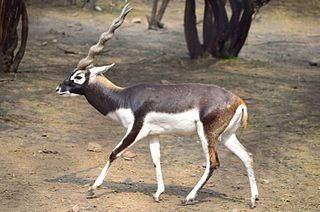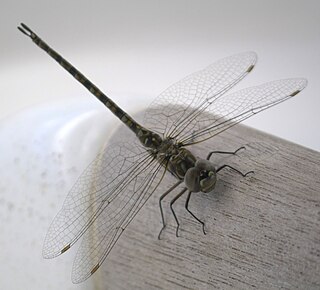
Arachnida is a class of joint-legged invertebrate animals (arthropods), in the subphylum Chelicerata. Arachnida includes orders containing spiders, scorpions, ticks, mites, harvestmen, and solifuges. In 2019, a molecular phylogenetic study also placed horseshoe crabs in Arachnida.

Wolf spiders are members of the family Lycosidae, from the Ancient Greek word "λύκος" meaning "wolf". They are robust and agile hunters with excellent eyesight. They live mostly in solitude and hunt alone, and do not spin webs. Some are opportunistic hunters pouncing upon prey as they find it or even chasing it over short distances. Some wait for passing prey in or near the mouth of a burrow.

Jumping spiders or the Salticidae are a family of spiders. As of 2019, it contained over 600 described genera and over 6000 described species, making it the largest family of spiders at 13% of all species. Jumping spiders have some of the best vision among arthropods and use it in courtship, hunting, and navigation. Although they normally move unobtrusively and fairly slowly, most species are capable of very agile jumps, notably when hunting, but sometimes in response to sudden threats or crossing long gaps. Both their book lungs and tracheal system are well-developed, and they use both systems. Jumping spiders are generally recognized by their eye pattern. All jumping spiders have four pairs of eyes, with the anterior median pair being particularly large.

Huntsman spiders, members of the family Sparassidae, are known by this name because of their speed and mode of hunting. They are also called giant crab spiders because of their size and appearance. Larger species sometimes are referred to as wood spiders, because of their preference for woody places. In southern Africa the genus Palystes are known as rain spiders or lizard-eating spiders. Commonly they are confused with baboon spiders from the Mygalomorphae infraorder, which are not closely related.

The Araneomorphae are an infraorder of spiders. They are distinguished by having chelicerae (fangs) that point diagonally forward and cross in a pinching action, in contrast to the Mygalomorphae, where they point straight down. Most of the spiders that people encounter in daily life belong to the Araneomorphae.

The blackbuck, also known as the Indian antelope, is an antelope native to India and Nepal. It inhabits grassy plains and lightly forested areas with perennial water sources. It stands up to 74 to 84 cm high at the shoulder. Males weigh 20–57 kg (44–126 lb), with an average of 38 kg (84 lb). Females are lighter, weighing 20–33 kg (44–73 lb) or 27 kg (60 lb) on average. Males have 35–75 cm (14–30 in) long, ringed horns, though females may develop horns as well. The white fur on the chin and around the eyes is in sharp contrast with the black stripes on the face. The coats of males show a two-tone colouration; while the upper parts and outsides of the legs are dark brown to black, the underparts and the insides of the legs are white. Females and juveniles are yellowish fawn to tan. The blackbuck is the sole living member of the genus Antilope and was scientifically described by Carl Linnaeus in 1758. Two subspecies are recognized.

The Antilopinae are a subfamily of Bovidae. The gazelles, blackbucks, springboks, gerenuks, dibatags, and Central Asian gazelles are often referred to as "true antelopes", and are usually classified as the only representatives of the Antilopinae. True antelopes occur in much of Africa and Asia, with the highest concentration of species occurring in East Africa in Sudan, Eritrea, Ethiopia, Somalia, Kenya, and Tanzania. The saigas and Tibetan antelopes are related to true antelopes (Antilopinae) and goats (Caprinae), but often placed in their own subfamily, Saiginae. These animals inhabit much of central and western Asia. The dwarf antelopes are sometimes placed in a separate subfamily, Neotraginae, and live entirely in sub-Saharan Africa.

Tarantulas comprise a group of large and often ″hairy″ spiders of the family Theraphosidae. Currently, about 1,000 species have been identified. The term tarantula is usually used to describe members of the family Theraphosidae, although many other members of the same infraorder (Mygalomorphae) are commonly referred to as "tarantulas" or "false tarantulas". Some of the more common species have become popular in the exotic pet trade. Many New World species kept as pets have urticating hairs that can cause irritation to the skin, and in extreme cases, cause damage to the eyes.

Precis antilope, the darker commodore, is a species of butterfly in the family Nymphalidae, native to Subsaharan Africa.

Spiders are air-breathing arthropods that have eight legs, chelicerae with fangs generally able to inject venom, and spinnerets that extrude silk. They are the largest order of arachnids and rank seventh in total species diversity among all orders of organisms. Spiders are found worldwide on every continent except for Antarctica, and have become established in nearly every habitat with the exceptions of air and sea colonization. As of July 2019, at least 48,200 spider species, and 120 families have been recorded by taxonomists. However, there has been dissension within the scientific community as to how all these families should be classified, as evidenced by the over 20 different classifications that have been proposed since 1900.

Hypolimnas antilope, the spotted crow eggfly, is a butterfly of the family Nymphalidae. It is found from Malaya to the Philippines, New Guinea and Australia.
Artediellina antilope is a species of sculpin native to the Sea of Okhotsk where it occurs at depths of from 300 to 615 metres. This species is the only known member of its genus.

Phoneyusa is a genus of spiders belonging to the family Theraphosidae (tarantulas).
The World Spider Catalog (WSC) is an online searchable database concerned with spider taxonomy. It aims to list all accepted families, genera and species, as well as provide access to the related taxonomic literature. The WSC began as a series of individual web pages in 2000, created by Norman I. Platnick of the American Museum of Natural History. After Platnick's retirement in 2014, the Natural History Museum of Bern (Switzerland) took over the catalog, converting it to a relational database.
Typhistes is a genus of sheet weavers that was first described by Eugène Louis Simon in 1894.
Typhistes comatus, is a species of spider of the genus Typhistes. It is endemic to Sri Lanka.

Gomphaeschna antilope, the taper-tailed darner, is a species of darner in the dragonfly family Aeshnidae. It is found in North America.

Ancistrocerus antilope is a species of wasp of the family Vespidae.













